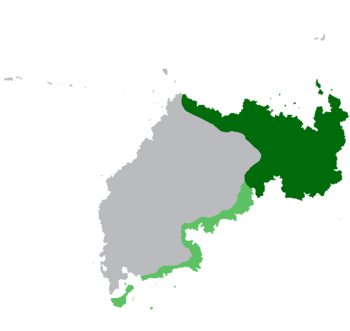Waranjala Empire: Difference between revisions
No edit summary |
No edit summary |
||
| (5 intermediate revisions by the same user not shown) | |||
| Line 1: | Line 1: | ||
{{Infobox former country |
{{Infobox former country |
||
| − | |native_name = |
+ | |native_name = ''Glɔ D̰lhọọ̃zgṛ́de Bruyba'' |
|conventional_long_name = Waranjala Empire |
|conventional_long_name = Waranjala Empire |
||
|common_name = Waranjala Empire |
|common_name = Waranjala Empire |
||
| Line 140: | Line 140: | ||
}} |
}} |
||
| − | The '''Waranjala Empire''' was a large hegemonic thalassocratic empire that stretched over much of eastern [[Jarruunh]]. Led by a small collection of confederated city-states, the empire quickly gained dominion over much of Jarruunh, mostly using their sophisticated bronze production and shipbuilding. The Empire was founded by a confederation of |
+ | The '''Waranjala Empire''' was a large hegemonic thalassocratic empire that stretched over much of eastern [[Jarruunh]]. Led by a small collection of confederated city-states, the empire quickly gained dominion over much of Jarruunh, mostly using their sophisticated bronze production and shipbuilding. The Empire was founded by a confederation of 5 major cities located in southeastern Jarruunh, [[Mãydhzul]], [[Dyiĩyiĩn]], [[Wõmrdi]], [[Nyoõl]], and [[Nhaadhbũw]]. The empire would be the most influential polity in the history of Jarruunh, as it would spread its lingua franca, the [[Classical Waranjala language]], across all of eastern Jarruunh. Over the course of the 17th century CY, the empire would gradually lose its hold over several cities and tributaries where it had established dominion, and by 1737 the empire had effectively collapsed. |
| + | |||
| + | ==Etymology== |
||
| + | The term ''Waranjala Empire'' is an anachronistic term for simplicity, particularly among scholars and historians in [[Huo]] and [[Yazland]]. This term has since spread amongst the modern [[Waranjala peoples]], particularly among ethno-nationalist and independence groups. During the 16th – 18th centuries, the Waranjala called the empire ''Glɔ D̰lhọọ̃zgṛ́de Bruyba'' (<small>lit.</small> “''land of the five Dlhozes''”). A ''Dlhoz'' being the traditional word for the ruler of a city. |
||
[[Category:Former countries]][[Category:Jarruunh]] |
[[Category:Former countries]][[Category:Jarruunh]] |
||
Latest revision as of 12:20, 15 November 2025
Waranjala Empire Glɔ D̰lhọọ̃zgṛ́de Bruyba | |
|---|---|
| c. 1200 CY–1737 CY | |
 Greatest extent of the Waranjala Empire shown in green, with tributaries shown in light green | |
| Common languages | Classical Waranjala |
| Government | Hegemonic military confederation |
| History | |
• Established | c. 1200 CY |
• Disestablished | 1737 CY |
The Waranjala Empire was a large hegemonic thalassocratic empire that stretched over much of eastern Jarruunh. Led by a small collection of confederated city-states, the empire quickly gained dominion over much of Jarruunh, mostly using their sophisticated bronze production and shipbuilding. The Empire was founded by a confederation of 5 major cities located in southeastern Jarruunh, Mãydhzul, Dyiĩyiĩn, Wõmrdi, Nyoõl, and Nhaadhbũw. The empire would be the most influential polity in the history of Jarruunh, as it would spread its lingua franca, the Classical Waranjala language, across all of eastern Jarruunh. Over the course of the 17th century CY, the empire would gradually lose its hold over several cities and tributaries where it had established dominion, and by 1737 the empire had effectively collapsed.
Etymology
The term Waranjala Empire is an anachronistic term for simplicity, particularly among scholars and historians in Huo and Yazland. This term has since spread amongst the modern Waranjala peoples, particularly among ethno-nationalist and independence groups. During the 16th – 18th centuries, the Waranjala called the empire Glɔ D̰lhọọ̃zgṛ́de Bruyba (lit. “land of the five Dlhozes”). A Dlhoz being the traditional word for the ruler of a city.